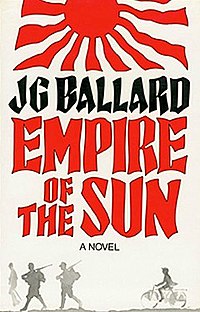 Cover of the first edition (hardback) | |
| Author | J. G. Ballard |
|---|---|
| Cover artist | Pat Doyle [1] |
| Language | English |
| Genre | Autobiographical, War |
| Publisher | Gollancz |
Publication date | 13 September 1984 |
| Publication place | United Kingdom |
| Media type | Print (Hardback & Paperback) |
| Pages | 278 pp (first edition, hardback) |
| ISBN | 0-575-03483-1 (first edition, hardback) |
| OCLC | 260149687 |
| LC Class | PR6052.A46 E45x 1984b |
| Followed by | The Kindness of Women |
Empire of the Sun is a 1984 novel by English writer J. G. Ballard; it was awarded the Guardian Fiction Prize, the James Tait Black Memorial Prize and was shortlisted for the Booker Prize. [2] Like Ballard's earlier short story "The Dead Time" (published in the anthology Myths of the Near Future ), it is essentially fiction but draws extensively on Ballard's experiences in World War II. The name of the novel is derived from the etymology of the name for Japan.
Contents
Ballard later wrote of his experiences in China as a boy and the making of the film of the same name in his autobiography Miracles of Life .